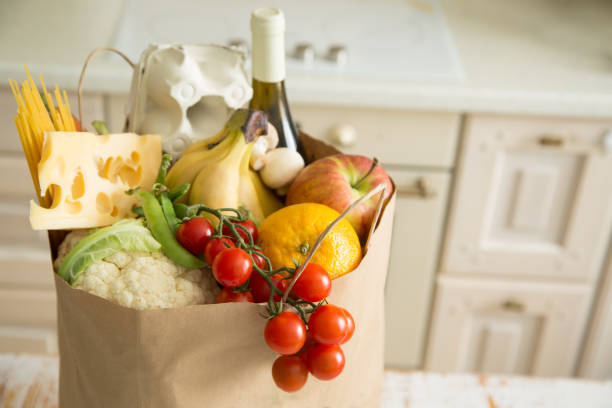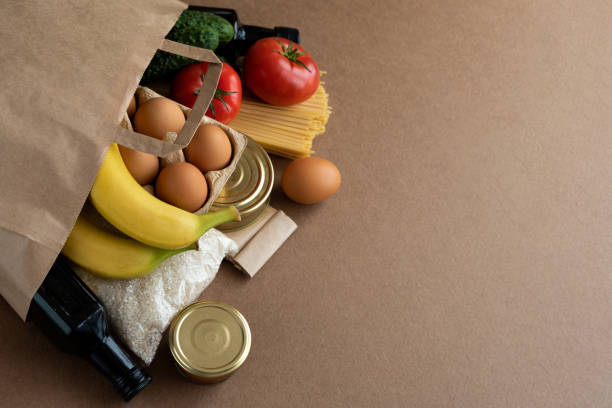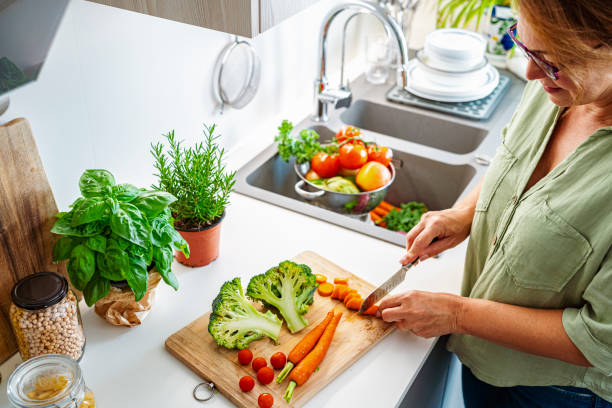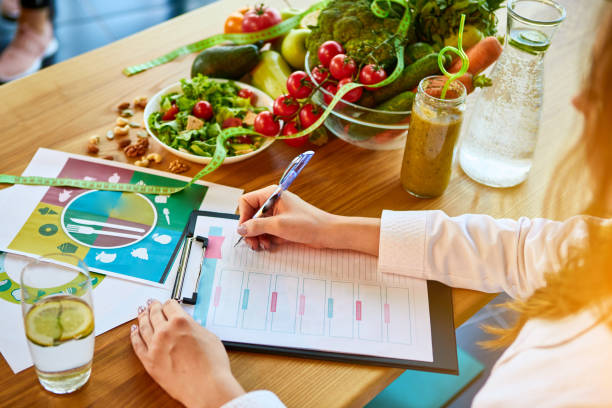Take a second to think about the things that you have in your main trash can at home. It is likely full with banana peels, milk cartons, plastic containers, and expired goods. Let’s not get into the gory details.
Recently, zero waste meal planning and consumption is gaining more attention, all thanks to the efforts that people are making towards reducing food waste and having sustainable kitchens.
The EPA estimates that 22% of all solid waste originates from food. Furthermore, according to the USDA, one-third of all food made for consumption is wasted or lost because people didn’t eat 31% of the 430 billion pounds meant for consumption. To introduce sustainable practices at home, we must overhaul the kitchen by focusing on zero waste meal planning because most household trash originates there.
What is Zero Waste Meal Planning?

In zero waste meal planning, you use all parts of your food, compost, and minimize food waste. Time, attention, and planning is necessary when planning zero-waste meals. Long-term, this will prove beneficial to reducing food waste. Zero waste meal planning will not only save you money, but it will also make you healthier.
How Zero Waste Meal Planning Helps with Reducing Food Waste

Whenever you grow or prepare food, then discard most of it after consumption, that leads to food waste. In the food chain, food waste can occur in any step – on the field, during transportation, or in the kitchen.
Staying on top of your nutrition goals is made easier with meal planning. Having a budget, however, means that you don’t have a lot of flexibility. To meet macros or provide essential calories, each ingredient must be carefully chosen.
Maintaining a zero-waste meal plan ensures that you are feeding your body without also polluting the environment; keeping extra food out of the house prevents poor choices from occurring and prevents excess waste from being sent to landfills. You make an intentional choice about what to eat and prepare by developing a weekly meal plan. You’re already starting to reduce your waste by doing this!
If you stick to your meal plan when you go grocery shopping, you don’t have to buy anything you don’t need. Food waste releases methane gas into landfills, so this is a great way to reduce it. Food waste contributes about 8% of the world’s greenhouse gas emissions.
Benefits of Zero Waste Meal Planning

Zero waste meal planning offers many benefits. The process not only reduces waste but also saves money and time. The following are some advantages of zero waste meal plans.
- Saves time
You can save a great deal of time through zero waste meal planning. You only need to go to the grocery store once instead of several times. You can simplify your life by cooking all your meals at once, rather than seven days a week.
- Fewer shopping trips
I visit the supermarket only once a week these days. In the past, I used to stop by all the time before I started zero waste meal planning. Because I hadn’t adequately planned for the week, I wasted valuable time at the grocery store. Additionally, since I never bought one thing at a time, I spent money. I wasted more money by purchasing more than I needed.
- Reduces food waste
Food waste results in greenhouse gas emissions that end up polluting the environment. Our atmosphere gets filled with 25 times more methane gas than carbon dioxide. You can create a zero waste grocery shopping list that includes only items that you will eat throughout the week, thus reducing food waste.
- Saves the environment
In addition to contributing to greenhouse gas emissions, wasted food contributes to global warming. As landfills fill up with waste, toxic gases escape into the air, resulting in global warming and the depletion of the ozone layer. You can reduce the impact on the environment through zero waste meal planning.
Levels of Zero Waste Meal Planning

Preparation will depend on factors such as time, space, and, let’s face it, interest. The good news is that there are lots of different ways to prepare meals. Make your choice! My zero waste meal planning involves three levels:
Stage 1: Basic
Here, the focus is on theoretical meal planning. A spreadsheet for zero waste meal planning, for instance, shows what to do without cooking anything beforehand. For those who do not have much freezer or refrigerator space or who cannot dedicate a large amount of time to meal preparation, this is a great option. The planning stage allows you to keep focus and identify what you’ll need each week.
Stage 2: Building blocks
This level is all about creating space and time for the building blocks. When I cook, I usually start with the big stuff. It is best to prepare the basics and leave the toppings and sides for the day you decide to cook.
A batch item usually includes:
- Broth
- Beans
- Rice
- Veggies
It is ideal for those who may not have time to cook during the week to spend some time on longer items. It’s also ideal for people who want guidance but prefer to be flexible on the actual meal, like spicing up rice with chili for tacos or flavoring it with soy sauce to put on stir-fries.
Stage 3: Making it all happen
During this stage, you will experience the most intense, full meal preparation. All the meals for the upcoming week need to be prepared, cooked and portioned out. This level fits people who have little downtime during the week. You have to put in a lot of effort early on, but the rest of the week will be easy.
Tips for Reducing Food Waste with Zero Waste Meal Planning

1. Check your inventory to see what you have
Before you head to the grocery store, you need to know what you have in your pantry, refrigerator, and freezer. Doing this will prevent you from wasting funds on food items you already have! Walk through your inventory and note what’s in it. This will help you figure out what you have and what you should use up first.
To double-check if I already have an ingredient for a recipe, I go through my pantry before I go grocery shopping. It’s easy for me to forget if I have things like chicken broth, canned beans, tomatoes, or breadcrumbs in my pantry, so I check my stock before adding these things to my shopping list.
2. Use up ingredients by planning meals around them
Take a look at your food supply for expired ingredients and pull them out while you are checking dates. Until the ingredient is all consumed, incorporate it into your weekly zero waste meal planning routine as often as possible.
Refrigerators can be arranged in the same manner. Meal plan around anything that needs to be used up right away! Try something new and get creative! If necessary, portions can also be frozen.
3. Use your leftovers
Zero waste meal planning helps you avoid wasting food. In any case, it all starts with what you have. If you have leftover vegetables and food scraps in your fridge, review and use them. Take a look at all your leftovers and find out how you can use them quickly.
Get creative and add leftovers to a recipe you already have. You can cook one dish using half green beans, onion, old carrots, and rice, for instance. It doesn’t matter how perfect your recipe is. You can save money and reduce food waste by using leftovers.
4. Eat whole, unprocessed foods
To ensure that you are reducing food waste, consider eating whole foods such as beans, vegetables, fresh fruits, grains, nuts, and so on. The health benefits of whole, unprocessed foods far outweigh those of canned or processed foods. Choose food with compostable or recyclable packaging materials if you need to buy packaged food.
5. Compost
As with recycling, composting should always be a last resort, not a first option. In most states, we have the option of composting our food waste. Those who live in apartment buildings without composting facilities may use community gardens in their area. You can ask around your community for people who accept compost and work with them.
Unlike a landfill, compost bins offer a more sustainable way of disposing of food waste. By composting an item, its nutrients are returned to the soil and the item will break down quickly.
Learn more about composting food waste by reading our Beginner’s Guide to Composting: Turning Waste into Nutrient-Rich Soil.
6. Plan your meals around your favorite dishes
Your meal planner template should include the things that are closest to going bad, as well as how you plan to use them to ensure that you are reducing food waste. Once you have your zero waste meal planning recipe, you can create other meals. Make a list of pantry items and add to it.
On a weekday, maybe you’ll make baked oatmeal for breakfast. You’ll likely use food from your pantry for a majority of that recipe, but perhaps you’ll want to add some fruits or something else to it. Whenever possible, use pantry staples to create easy-to-follow recipes, and feel free to add to them according to your budget and the season.
7. Get rid of animal products
There are several environmental dangers of meat consumption on the planet because of the high carbon footprint associated with conventional animal products. Eat beans and vegetables instead of factory-farmed meat if you still consume it. A vegetarian meal once a week is also a good idea.
Read More: 12 Eco-Friendly Benefits of Plant-Based Diets
8. Learn proper food storage
Keeping foods fresh is an art! You can extend the freshness of your products and minimize your waste by doing this.
- Airtight jars are ideal for storing pantry staples
- To prevent nuts from turning rancid, freeze them
- Separate potatoes from onions
- The fridge should contain a low-humidity drawer for apples and oranges
- Salad greens should be covered with a cloth
- Use a mason jar to store cilantro and parsley
- Carrots and celery should be kept in water
9. Keep an eye on expiration dates
You may be surprised to learn that expiration dates are merely suggestions. Because people throw away perfectly good food before its expiration date, food expiration dates contribute to climate change and global warming.
People no longer use their senses to determine if foods are fresh! Despite being extremely concerned about food safety, I also understand that most foods will let you know when they are safe to eat. It’s easy for me to tell whether foods are still safe to eat when I pay close attention to things like mold and bad smells.
10. Shop from zero waste shops
Plastic bags and packaging are a common part of shopping at the supermarket. A zero-waste shop offers several benefits. You can get fresh produce and pantry staples that can help you cook healthier meals while minimizing packaging waste. Follow these tips to shop in zero waste shops.
- Buy in bulk: You may not see the packaging when shopping at the bulk bins. It’s much better to buy big packages than little ones. The cost of package-free produce is lower, but you can also save money by buying in bulk.
- Go shopping once weekly: Shopping once a week (or even less) can help you reduce waste and reduce your budget. The chances of you seeing products on end caps or sale in a grocery store are higher. By limiting how often you go to the store, you’ll be able to stick to your zero waste meal plan.
Read More On: Zero-Waste Grocery Shopping: 10 Great Tips for Reducing Packaging Waste
11. Prepare simple meals
Simplicity is key when it comes to meal prepping. Make use of your pantry to cook meals. To create another unique dish, cook whole foods and mix them. Make a taco bowl with cheese, black beans, and roasted sweet potatoes or chicken thighs and roasted sweet potatoes.
12. Cook in batches
When you batch cook, you prepare a lot of food at once. Make all the meals for the week ahead at once instead of making one meal at a time. After preparing these meals, store them in a reusable storage container and keep them in the refrigerator. By doing this, instead of grabbing takeout after work every day, you can have a healthy dinner waiting for you at home.
You can save money on groceries and save time by batch cooking. To cook a specific recipe, only purchase the ingredients that you need rather than buying a lot of different ingredients for each meal. As a result, food waste can be reduced.
- Prepare meals in bulk by thinking of recipes that the whole family will enjoy and prepare a grocery list.
- When you’ve finished, shop at the grocery store or zero waste shop for all the supplies you need.
- The last step is to cook everything at once, store it in the fridge, and then reheat it whenever you want to eat it.
13. Dish out smaller food portions first
Some of the food that ends up in the garbage bin is served because we overestimate how much we consume. You can start serving smaller portions and add more if necessary if you’re eating with a group of friends. At a party, you can serve lunch or dinner on small bowls or plates.
14. Buy reusable containers
There is more to zero waste meal planning than creating a list. It is necessary to store meals until you are ready to consume them after deciding what meals to prepare. Consider investing in stainless steel or glass meal prep containers. Using silicone bags instead of ziploc bags is a great option for storing leftover food in plastic containers.
15. Do not throw away your food scraps
Do you know what you can do with onion skins or carrot peels? We typically discard our food scraps in the trash. Wouldn’t it be nice if these scraps could be turned into broth or smoothies? Storing and using those food scraps can reduce food waste. Scraps can be added to existing recipes or created from scratch.
Adding salt or chili powder to food fragments, adding water, and letting it cook until it becomes broth is an example of how you can cook them in your instant pot. A smoothie can be made from fruit scraps like pineapple or banana pieces.
In conclusion
Zero waste meal planning can benefit you and the environment. If you plan your meals, you can buy only what you need to store for a week or a month. We will therefore end up reducing food waste. In addition to saving money, time, and energy, you can also improve the environment. Making small changes towards this lifestyle can have a significant impact on the environment and provide a variety of benefits.







